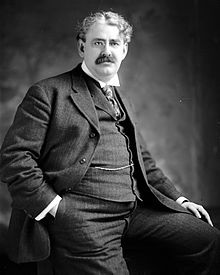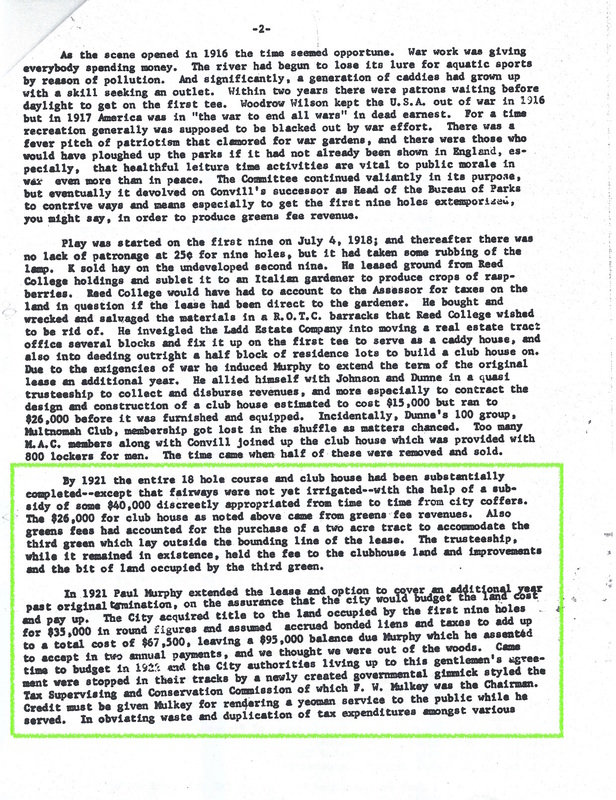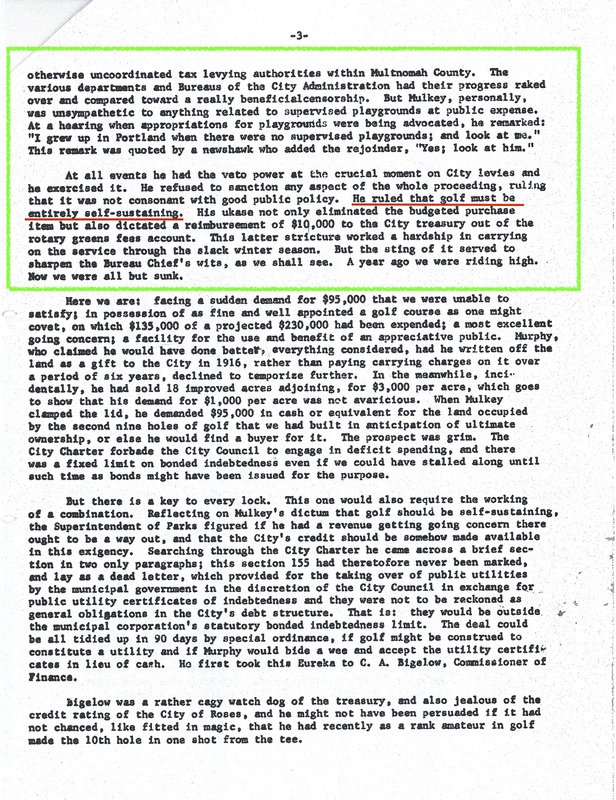"A year ago we were riding high. Now we are all but sunk." Eastmoreland Origin Story - Part 39/28/2016 "A year ago we were riding high. Now we are all but sunk." 1922 Frederick W. Mulkey, Tax Supervisor who ruled golf must be self-sustaining. '“I grew up in Portland when there were no supervised playgrounds; and look at me.” This remark was quoted by a newshawk who added the rejoinder, “Yes; look at him!” Frederick W. Mulkey, Tax Supervisor who ruled golf must be self-sustaining. '“I grew up in Portland when there were no supervised playgrounds; and look at me.” This remark was quoted by a newshawk who added the rejoinder, “Yes; look at him!” In 1921, the entire 18 holes of Eastmoreland golf course was essentially complete. There would be still much earth projects to make the course playable, irrigation and drainage would have to be built. We're in Oregon after all, and one constant is rain, rain, and more rain. So we can only imagine how waterlogged the fairways might have been in 1921 and then subsequently baked out in the summer. (Sidenote: extensive research and articles will help tell the story of the maintenance crew which over the years has polished and cut this gem to its current state which, under the direction of Superintendent Kathy Hauff, at certain times of the year the greens will rival even the most manicured private clubs.) Overall as Keyser states later that by 1921 "we were riding high." The reasons are quite plain, the Eastmoreland golf course greens fees were turning out consistent revenue, the course was packed, the layout across crystal springs served as a bellwether for modern golf in the western states. This entire project conceived and started less than 5 years earlier could be called nothing but a marvel and great success. Further, the Committee formulated a 'gentleman's agreement' to ensure that the municipal golf links would remain in public hands by working out a deal with Paul Murphy, then President of the Ladd Estate Company - for the City to acquire full deed to the land occupied by the back 9 - and some adjacent property for the third green - which was placed on the far side of the Johnson Creek. (Sidenote: Johnson Creek was later rerouted though this occurred many years later in the 1950's or 1960's as will be determined) The economics of the deal, as will be shown later, prove to be a fair deal at or under the market - in the spirit of what truly was a gentleman's agreement. It's not that Mr. Murphy was purely charitable - he was afterall developing the entire Eastmoreland neighborhood at the time and marketing the fact that one could "work downtown and live along the golf course in Eastmoreland." Though it's equally fair to say Paul Murphy was a true friend to golf and visionary for community building - as he later built out the town of Lake Oswego and the Oswego Lake Country Club using the same golf course architect W. Chandler Egan. It's at this point our villain arrives on the scene, in the form of a Tax Supervising & Conservation Committee. Yes our dear brothers in the Eastmoreland Golf Club were set against by an early ancestor of the tax cutting "club for growth" led by F. W. Mulkey. Mulkey a early member of the Young Republicans having graduated from University of Oregon in 1896 with a degree in law and political aspirations that led to him serving as President of the City Council for a year and completed two terms as Unites States Senator from 1907-1918. Though it should be noted his two brief terms as U.S. Senator lasted less than a total of 9 months combined- both times as a replacement for sitting Senators who had to step down and serving a replacement before appointing his would-be-successor. At this point Mulkey is fresh off his last stint as pinch-Senator, making way for another candidate to go through the pain of actually running for office, and is elected chair of this newly created Tax Committee. Now Keyser actual pays a fair amount of respect and admiration to Mulkey for his "yoeman service" (efficient, loyal service), though you wonder if there is more than a hint of irony. Further, as I suggested at the start, the ruling itself is the catapulting event - in the screenplay world we might call it 'hero's call to action.' The City ruling 'golf must be entirely self-sustaining" sets in motion a mission and chain of events and decisions that is arguably the hallmark of its greatness as a municipal service. That said, at the time of the ruling, the details of the financials reveal that truly "all hope is lost." Because despite growing greens fees revenues, the income could not hope to meet minimum maintenance requirements and the obligations of the gentleman's agreement. On top of that, the stipulation that the Municipal Golf Revenue must pay back $10,000 to the City treasury first added an immediate undue burden. So you have to wonder if Mulkey's ruling was intended by design as a death blow to municipal golf and an opening for privateers seeking to purchase the distressed property (as will be evidenced in coming part 4). Keyser's own opinion may be discerned by his labeling of the 'ukase ruling': From the Russian term meaning "decree" by a Tzar, the word ukase has entered the English language with the meaning of "any proclamation or decree; an order or regulation of a final or arbitrary nature." In fairness to Mulkay, it does appear that the leaders influencing the City and requisitioning budget allotments, which certainly included if not lead by Keyser himself, had perhaps blurred the lines, as he mentioned earlier that the back nine was completed by a 'subsidy of $40,000 discreetly appropriated time to time from city coffers.' So maybe Mulkey did have a point... though one must wonder if the golf course and the entire park system Keyser envisioned was an easy target. By 1921 the entire 18-hole course and Clubhouse have been substantially completed -- except that fairways or not yet irrigated -- with the help of a subsidy of some $40,000 discreetly appropriated from time to time from City coffers. The $26,000 clubhouse as noted above came from greens fee revenues also greens fees had accounted for the purchase of a two acre tract to accommodate the third green which lay outside the founding line of the lease. The trusteeship, while it remained in existence, held the fee to the clubhouse land and improvements and the bit of land occupied by the third green. |
|


 RSS Feed
RSS Feed